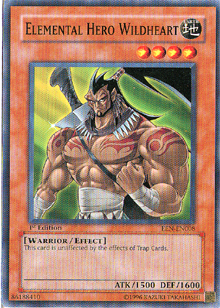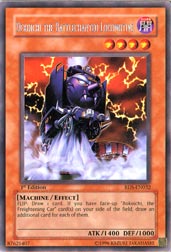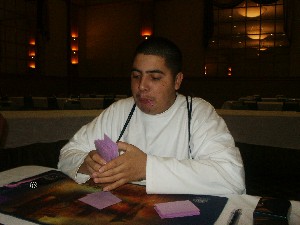My goal here on Metagame.com is to make you, the reader, a better Yu-Gi-Oh! TCG player. I know it’s pretty arrogant for me to claim to have the power to make everyone who’s reading this into an expert. How can I make such a statement, you ask? Simple. I’m going to walk you through my own philosophies on everything Yu-Gi-Oh! and ask you to take it all with a grain of salt. Everything I write from this point on is my opinion on this card game, and I ask you to consider my opinions as those of a dedicated player, and nothing more. My goal is to teach you something. I’m going to tell you how things work and why, and then, I want you to take it to the next level. Elaborate on my teachings and apply them for yourselves. Hopefully after all this, you’ll understand how to make yourself a better player. I would be perfectly happy knowing that I helped everyone else become a better player—and that, my friends, is my ultimate goal.
Easy-Peezy, Lemon Squeezy
Winning a game of Yu-Gi-Oh! is as simple (and as difficult) as dealing 8000 points of direct damage to your opponent’s life points. The primary focus on dealing damage will be attacking with monsters. You are granted one normal summon and one battle phase per turn, which allows you to summon monsters that’ll attack your opponent. Your opponent is allowed to set one monster per turn and as many spell or trap cards as he or she has in order to prevent your attacks from hitting their life points. This is the most basic concept behind Yu-Gi-Oh!, and it’s one that every duelist uses every time they play. Yet, by looking at the Top 8 decklists and every feature match from any Shonen Jump Championship, we know that attacking and defending does so much more than simply inflicting life point damage.
 Attacking is the best way to put your opponent at a disadvantage. A successful attack to your opponent’s life points gets you one step closer to victory. Even more important, however, is a successful attack that destroys an opponent’s monster. If your D.D. Assailant attacks your opponent’s Elemental Hero Wildheart, then you’ve gained an advantage on your opponent. Your opponent has lost card presence as well as field tempo. This is the strength of the Warrior Toolbox deck—to be able to summon bigger monsters and attack smaller ones to gain advantage. To prevent this loss in advantage, players will usually do one of the following three things.
Attacking is the best way to put your opponent at a disadvantage. A successful attack to your opponent’s life points gets you one step closer to victory. Even more important, however, is a successful attack that destroys an opponent’s monster. If your D.D. Assailant attacks your opponent’s Elemental Hero Wildheart, then you’ve gained an advantage on your opponent. Your opponent has lost card presence as well as field tempo. This is the strength of the Warrior Toolbox deck—to be able to summon bigger monsters and attack smaller ones to gain advantage. To prevent this loss in advantage, players will usually do one of the following three things.
First, a player who doesn’t want to take an attack could easily set a defensive spell or trap card. This is the simplest way to repel an attack, but defensive spells and traps can be manipulated. Spell and trap removal is abundant, and when they’re attached to a 2400 ATK body in the form of Mobius the Frost Monarch, they can be especially deadly. Imagine that one player tribute summons Mobius, destroying Sakuretsu Armor, and then attacks and destroys a set Elemental Hero Wildheart. Those are huge advantage swings that no player can afford to take lightly.
The second option for a player is for him or her to simply not set any monsters. If you commit no monsters to the field, you can’t lose any in battle. However, most players will find that this strategy is unsuccessful when lots of attacks drop their life points to 0. Remember, maintaining a high number of cards and losing no card presence mean nothing if you lose the game.* This forces players to find a different way to avoid losing advantage in battle. The third of these options has been discovered, and it’s . . .
“Flip, Flop”
 . . . through flip effects! In order to protect one’s life points in a pinch, a player can set flip effect monsters. These monsters trade their bodies with other cards. Magician of Faith will grab a spell card from your graveyard, Dekoichi the Battlechanted Locomotive will trade itself to draw a card off the top of your deck, and Old Vindictive Magician trades itself with a monster on your opponent’s side of the field. The drawback? Flip effect monsters lose field presence. The small cost of not losing raw card presence in battle is losing a monster on the field.
. . . through flip effects! In order to protect one’s life points in a pinch, a player can set flip effect monsters. These monsters trade their bodies with other cards. Magician of Faith will grab a spell card from your graveyard, Dekoichi the Battlechanted Locomotive will trade itself to draw a card off the top of your deck, and Old Vindictive Magician trades itself with a monster on your opponent’s side of the field. The drawback? Flip effect monsters lose field presence. The small cost of not losing raw card presence in battle is losing a monster on the field.
On the other hand, this drawback is offset by the possible advantages that flip effects can generate. For example, a flip effect monster with a high ATK value could flip face up, generate an effect to grab an extra card, then attack an opposing monster. This is why good flip effect monsters have to have low ATK and DEF values. One exception to this rule is Gravekeeper’s Spy. While I could write an entire series on why Gravekeeper’s Spy is so awesome, I will instead shorten it down to this: Having a flip effect monster that’s able to gain advantage by using its effect and then remaining on the field after an attack is very, very good.
The power behind flip effects doesn’t end there. A flipped Dekoichi the Battlechanted Locomotive can be deadly. While Dekoichi doesn’t have the ATK power necessary to take down any monsters that aren’t flip effects themselves, it can still attack directly. In conjunction with another monster, Dekoichi can continuously pound the opponent for 1400 damage. The beauty for the player who flipped Dekoichi is that he or she doesn’t need to worry about losing it in battle. It’s already generated its advantageous effects, and losing it in battle will just negate the advantage already earned and return the card presence back to even.
However, the weakness in flip effects can sometimes take its toll. Players running decks that were too oriented on flip effects quickly found their fields swarmed with beefy monsters armed with Royal Decree. If that flip player was unable to draw Snatch Steal or Dark Hole, they’d be done in simply by too much ATK. Flip effect hate is also abundant in a format where flip effects are overplayed. Take the Shonen Jump Championship at Durham. Many veteran players such as Jordan Savage were main decking a pair of Mystic Swordsman LV2s to counter the flip-based metagame.
Thus came the era of self-replacing monsters. Remember the days of D. D. Warrior Lady, D. D. Assailant, Shining Angel, Mystic Tomato, and Sangan? These monsters took the principles of flip effects and added field presence to the mix. In addition to being defensive powerhouses, they could attack back instantly, rather than having to wait a turn to set and be flipped.
Unfortunately, on the defensive, they could still be hated on by face-down removal. The self-replacing monsters also lacked something the flip effects strived in, which is weakening face-up removal. Mystic Tomato may as well have, “Smashing Ground this!” written all over it. Remaining face up on the field makes the self-replacing monsters into targets, and chances are good that your 1400 ATK Tomato won’t remain on the field nearly as long as your 1400 ATK Dekoichi the Battlechanted Locomotive.
Back on the Attack
Now you’ve seen some of the theories behind defensive monsters. How does the attacker smash the defensive player and plow through his or her defensive monsters? If you seek the answer for this question, look no further than the Top 8 decklists of Shonen Jump Championship Chicago. The Shonen Jump in Chicago was at the start of the format when players were just coming out from a very defensive format. Looking to find something to take from the last format, players saw Warrior Toolbox decks take Shonen Jump Seattle and a very defensive metagame by storm. This deck thrived on using its battle phase more productively than any deck had done in that format. If we take a look at a more updated Warrior Toolbox monster lineup, we can analyze just how this was done.
Lazaro Bellido
Top 4, Shonen Jump Chicago
Monsters: 18
1 Magician of Faith
1 Magical Merchant**
1 Exiled Force
1 Breaker the Magical Warrior
1 Mobius the Frost Monarch
1 Chaos Sorcerer
2 D. D. Assailant
1 D. D. Warrior Lady
2 Cyber Dragon
1 Blade Knight
1 Sangan
2 Spirit Reaper
1 Don Zaloog
1 D.D. Survivor
1 Mystic Swordsman LV2
 I’ve separated this list into three parts. The first group contains Lazaro’s defensive monsters. For the most part, these monsters are used to defend Lazaro’s life points, while also not losing any card presence. The second group of monsters contains those that are primarily used for generating card and tempo advantages out of battle. The topic of advantage outside of the battle phase will be left for chapter two of this series, and so I will not touch on these monsters today. But the final (and by far the largest) group is the collection of monsters that do their thing in the battle phase.
I’ve separated this list into three parts. The first group contains Lazaro’s defensive monsters. For the most part, these monsters are used to defend Lazaro’s life points, while also not losing any card presence. The second group of monsters contains those that are primarily used for generating card and tempo advantages out of battle. The topic of advantage outside of the battle phase will be left for chapter two of this series, and so I will not touch on these monsters today. But the final (and by far the largest) group is the collection of monsters that do their thing in the battle phase.
We can definitely see some self-replacing monsters in this pile. D. D. Assailant and D. D. Warrior Lady embody all the versatility that I mentioned before. Spirit Reaper can’t be destroyed as a result of battle, and thus could also be considered a “self-replacing” monster, in the sense that it won’t lose advantage during battle, though it doesn’t replace itself because it isn’t destroyed in the first place. Spirit Reaper and Don Zaloog use the battle phase for a different purpose—they attack the hand. By dealing damage to an opponent, these monsters can slice a card directly out of the opponent’s hand. This is an exceptional way to use the battle phase. Since monsters can’t be destroyed to gain advantage, attacking with Spirit Reaper or Don Zaloog will throw a new threat towards an opponent.
Spirit Reaper is a whole new box of cookies on its own. This monster takes everything you want on defense and combines it with everything you want on attack. Even without the threat of being able to take down monsters in battle, Spirit Reaper is a constant threat to your opponent’s hand. Players have to remove this card from the field as soon as they can, and are willing to accept a -1 trade in card presence to do so.
The rest of the monsters aim to generate advantage in the battle phase by attacking certain monsters. Cyber Dragon loves to smack around anything with weaker ATK values, while Blade Knight, Mystic Swordsman LV2, and D. D. Survivor set their sights on the face-down monsters. Sangan is always a versatile powerhouse, shifting to the attack whenever the opportunity presents itself. Blade Knight and D. D. Survivor double up as high attackers that can attack directly or swing on opposing little guys. The key to Lazaro’s success was his ability to fully utilize the battle phase. While his opponents could only make simple attacks to Lazaro’s life points or smaller monsters, Lazaro had a wide range of attacks to make.
The Lesson
What I want you to take away from this article is the importance of attacking in the battle phase. The most basic way to detract from your opponent’s card and field presence is to destroy a monster in battle. This is something a lot of players have been forgetting recently, and it has led to a very defensive metagame. If the attacking deck has enough face-down removal, it should be able to overcome the defensive player easily enough. Learn how to play your monsters (both face up and face down) and take control of the battle phase to gain card presence, and you will find duels become a lot easier. Defensive players, I hope that knowing exactly how aggressive players can defeat you will help you defend against that! Learn how to minimize battle advantages and shut down the battle phase.
* See Michael Fukuyama vs. Nareg Torossian in the finals of Shonen Jump Indy, where Fukuyama’s dominating card presence was useless as Nareg attacked all of his life points away.
** Canadians love to play with one copy of Magical Merchant, for what seems like no real reason.